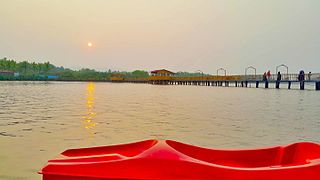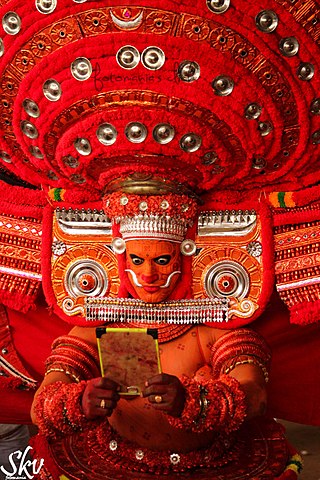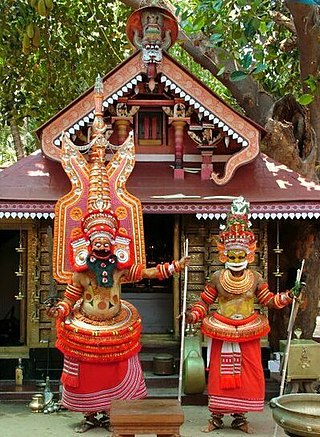
Kannur is one of the 14 districts along the west coast in the state of Kerala, India. The city of Kannur is the district headquarters and gives the district its name. The old name, Cannanore, is the anglicized form of the Malayalam name "Kannur". Kannur district is bounded by Kasaragod District to the north, Kozhikode district to the south, Mahé district to the southwest and Wayanad District to the southeast. To the east, the district is bounded by the Western Ghats, which forms the border with the state of Karnataka. The Arabian Sea lies to the west. Paithalmala is the highest point in Kannur District (1,372m). Enclosed within the southern part of the district is the Mahé district of the Union Territory of Puducherry. The district was established in 1957.

Theyyam is a Hindu religious ritual practiced in northern Kerala and some parts of Karnataka. Theyyam is also known as Kaḷiyāṭṭaṁ or Tiṟa. Theyyam consists of traditions, rituals and customs associated with temples and sacred groves of Malabar. The people of the region consider Theyyam itself as a channel to a god and they thus seek blessings from Theyyam.

The Tulu people or Tuluvas are an ethno-linguistic and ethno-cultural group from Southern India. They are native speakers of the Tulu language and the region they traditionally inhabit is known as Tulu Nadu. This region comprises the districts of Dakshina Kannada and Udupi in Karnataka and part of Kasaragod district in Kerala, with Mangalore, Karnataka being the commercial hub. The Census report of 2011 reported a population of 1,846,427 native Tulu speakers living in India.

Parassini Madappura Sree Muthappan temple is a temple located at Parassinikadavu in Anthoor municipality on the banks of the Valapattanam river about 10 km (6.2 mi) from Taliparamba and 20 km (12 mi) from Kannur town in Kannur district, Kerala, India. Thiyya community urayima Principal deity of the temple is Sree Muthappan, whose divinity is presented as a ritualistic theyyam enactment in two versions called Thiruvappan and Vellattam. According to the local tradition the presiding deity is a manifestation of Lord Shiva.

Muthappan is a deity commonly worshiped in the Kannur, Kasargod, Kozhikode, Malappuram region of Kerala and Coorg region of Karnataka in India. Muthappan is considered as the personification of two Hindu gods — the Thiruvappan or Valiya Muthapan (Vishnu) and the Vellatom or Cheriya Muthapan (Shiva).

The culture of Kerala has developed over the past millennia, influences from other parts of India and abroad. It is defined by its antiquity and the organic continuity sustained by the Malayali people. Modern Kerala society took shape owing to migrations from different parts of India and abroad throughout Classical Antiquity.
Kandankali is a village in Kerala, India. The village is situated about two kilometers south of the town of Payyanur in Kannur district.
Kannapuram is a census town and grama panchayat in Kannur district of North Malabar region in the Indian state of Kerala.
Punnad is a village in Kannur district in the state of Kerala, India.

Madayikavu (Māḍāyik्kavu), also known as Thiruvarkadu Bhagavathi Temple, is a significant ancient Kaula Shakti shrine in Kerala, located near Pazhayangadi, Kannur. With a distinguished history spanning over two millennia, the Kavu was administered by various regional dynasties. The Bhagavathi was revered by these dynasties as their royal family deity, and they also carried out renovations of the Kavu at multiple junctures throughout history.

Kummattikali or Kummatti Kali is the famous colorful mask-dance of Kerala, prevalent in Thrissur District, Palakkad District and parts of South Malabar. During the festival of Onam, Kummattikali performers move from house to house collecting small gifts and entertaining people. Kummatti dances are rampant in the Thrissur district during Onam. Pristine or original form of Kummattikali can be seen in the Bhadrakali temple in Palakkad district.

Chinakkathoor Bhagavathi Temple is a Hindu temple located at Palappuram near Ottapalam in Palakkad district of Kerala, India. The temple is well-known for the Chinakkathoor pooram held annually in the Malayalam month of Kumbham.
Orkkatteri is a small town in Kozhikode district in the North Malabar region of state of Kerala, India. This is the center town for Eramala grama panchayath.
Mavichery is a village which is the part of Pariyaram Gramapanchayath in the Kannur district of Kerala, India.

Kalarivathukkal Bhagavathy Temple, Bhadrakali Shrine located near Valapattanam river, is the family shrine of Chirakkal Royal Family. The deity of the shrine is the fierce form of Bhadrakali. Kalarivathukkal Bhagavathy is considered as the mother of the ancient martial art Kalarippayattu and hence the name. The shrine is administered by Malabar Devaswom Board and classified as Category A Temple of the board. Kalarivathukkal has come from the word Kalari Vaatilkal.

Pepita Seth is a British-born writer and photographer, known for her accounts of the temple arts and rituals of Kerala and her photographs of the widely celebrated captive elephant, Guruvayur Keshavan. The Government of India honoured her, in 2012, with the Padma Shri, the fourth highest civilian award, for her services to the field of art and culture.

Thirayattam is a ritualistic art form that is performed annually in the South Malabar region of the Indian state of Kerala. It is a tribal art form that combines dance, acting routines, songs, instrumental music, face writing, martial arts and rituals.

Chinakkathoor Pooram is a festival held annually at the Chinakkathoor Bhagavathi temple at Palappuram in Palakkad district of Kerala, India. A huge procession of 27 festooned tuskers is the highlight of the festival. The festival is celebrated in the Kumbham month of Malayalam calendar.

Neeliyar Kottam is a sacred grove in Kannur district, Kerala, India, situated at Mangattuparamba near Dharmasala. At present, this 20.18 Acre sacred grove is controlled by members of Cheriya Veedu family belonging to the Kulala community.














